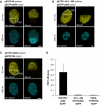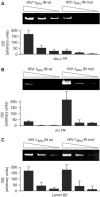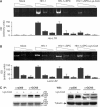Acetylation of HIV-1 integrase by p300 regulates viral integration
- PMID: 16096645
- PMCID: PMC1201351
- DOI: 10.1038/sj.emboj.7600770
Acetylation of HIV-1 integrase by p300 regulates viral integration
Abstract
Integration of HIV-1 into the human genome, which is catalyzed by the viral protein integrase (IN), preferentially occurs near transcriptionally active genes. Here we show that p300, a cellular acetyltransferase that regulates chromatin conformation through the acetylation of histones, also acetylates IN and controls its activity. We have found that p300 directly binds IN both in vitro and in the cells, as also specifically demonstrated by fluorescence resonance energy transfer technique analysis. This interaction results in the acetylation of three specific lysines (K264, K266, K273) in the carboxy-terminus of IN, a region that is required for DNA binding. Acetylation increases IN affinity to DNA, and promotes the DNA strand transfer activity of the protein. In the context of the viral replication cycle, point mutations in the IN acetylation sites abolish virus replication by specifically impairing its integration capacity. This is the first demonstration that HIV-1 IN activity is specifically regulated by post-translational modification.
Figures








Similar articles
-
GCN5-dependent acetylation of HIV-1 integrase enhances viral integration.Retrovirology. 2010 Mar 12;7:18. doi: 10.1186/1742-4690-7-18. Retrovirology. 2010. PMID: 20226045 Free PMC article.
-
Enhancement of the p300 HAT activity by HIV-1 Tat on chromatin DNA.Virology. 2001 Oct 25;289(2):312-26. doi: 10.1006/viro.2001.1129. Virology. 2001. PMID: 11689053
-
Acetylation of HIV-1 Tat by CBP/P300 increases transcription of integrated HIV-1 genome and enhances binding to core histones.Virology. 2000 Nov 25;277(2):278-95. doi: 10.1006/viro.2000.0593. Virology. 2000. PMID: 11080476
-
Tat acetylation: a regulatory switch between early and late phases in HIV transcription elongation.Novartis Found Symp. 2004;259:182-93; discussion 193-6, 223-5. Novartis Found Symp. 2004. PMID: 15171254 Review.
-
Distinct GCN5/PCAF-containing complexes function as co-activators and are involved in transcription factor and global histone acetylation.Oncogene. 2007 Aug 13;26(37):5341-57. doi: 10.1038/sj.onc.1210604. Oncogene. 2007. PMID: 17694077 Review.
Cited by
-
A proteomic screen of Ty1 integrase partners identifies the protein kinase CK2 as a regulator of Ty1 retrotransposition.Mob DNA. 2022 Nov 18;13(1):26. doi: 10.1186/s13100-022-00284-0. Mob DNA. 2022. PMID: 36401307 Free PMC article.
-
The Ubiquitin Proteasome System as a Double Agent in Plant-Virus Interactions.Plants (Basel). 2021 May 6;10(5):928. doi: 10.3390/plants10050928. Plants (Basel). 2021. PMID: 34066628 Free PMC article. Review.
-
GCN5-dependent acetylation of HIV-1 integrase enhances viral integration.Retrovirology. 2010 Mar 12;7:18. doi: 10.1186/1742-4690-7-18. Retrovirology. 2010. PMID: 20226045 Free PMC article.
-
Methods for integration site distribution analyses in animal cell genomes.Methods. 2009 Apr;47(4):261-8. doi: 10.1016/j.ymeth.2008.10.028. Epub 2008 Nov 25. Methods. 2009. PMID: 19038346 Free PMC article.
-
Allosteric HIV Integrase Inhibitors Promote Formation of Inactive Branched Polymers via Homomeric Carboxy-Terminal Domain Interactions.Structure. 2021 Mar 4;29(3):213-225.e5. doi: 10.1016/j.str.2020.12.001. Epub 2020 Dec 23. Structure. 2021. PMID: 33357410 Free PMC article.
References
-
- Bandyopadhyay D, Okan NA, Bales E, Nascimento L, Cole PA, Medrano EE (2002) Down-regulation of p300/CBP histone acetyltransferase activates a senescence checkpoint in human melanocytes. Cancer Res 62: 6231–6239 - PubMed
-
- Cara A, Guarnaccia F, Reitz MS, Gallo RC, Lori F (1995) Self-limiting, cell type-dependent replication of an integrase-defective human immunodeficiency virus type 1 in human primary macrophages but not T lymphocytes. Virology 208: 242–248 - PubMed
-
- Carrozza MJ, Utley RT, Workman JL, Cote J (2003) The diverse functions of histone acetyltransferase complexes. Trends Genet 19: 321–329 - PubMed
Publication types
MeSH terms
Substances
LinkOut - more resources
Full Text Sources
Other Literature Sources
Miscellaneous

